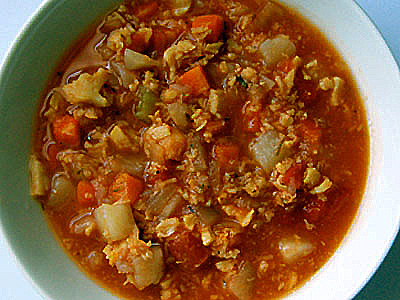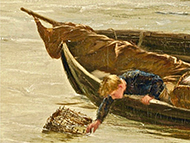Making My Self . . . and Dinner
The Spirit of the Form
Most parts of us perish during our lifetime only to be [replaced] by other perishable parts. . . . What remains the same, in good part, is the construction plan for our organism. . . . Call it the spirit of the form. . . .
Antonio Damasio
The Feeling of What Happens: Body and Emotion in the Making of Consciousness
I will take a deep breath, try to ignore the audacity of the undertaking, and begin. This really is an audacious undertaking, at least for me. Not so much the making of a chowder, but the making of a self. What I have done so far in the making-a-self-department is to allow a self to be made for me. I think that’s what most people do.
Where am I going to start? How am I going to start? I’ll begin with the easier part, the chowder. The self will come later.
I’ll begin the chowder as my mother began it. First she got everything together, all the ingredients and equipment that she would need to make the chowder. “I like to have everything out where I can see it,” she said. “I don’t want to forget anything, and I don’t want to have to stop what I’m doing and hunt for an onion.”
It always looked like chaos to me. Today I’d call it her mise en place. She would have laughed in my face if I’d called it that. Of course, I never could have called it that, because the only French I knew was French kissing.
I don’t have my mother’s recipe for chowder. She kept it in her head. I doubt that she ever wrote it down. If anyone had asked her for her recipe, she would have responded with a story, a story about making of a batch of chowder. To make a chowder like hers, she would have expected you to put yourself into the story.
I wish that she had written the recipe down, the basic recipe, because I don’t remember it well, and a written record would help. I would like to be able to follow that recipe, to see if I could bring back the chowder of my childhood, the flavor of my mother’s kitchen, and my mother, and my little self.
It wouldn’t work, because my mother’s recipe for chowder was a shifting, elusive thing. There was no “chowder of my childhood”; there were many chowders, each batch a bit different from the others. Though my mother made chowder at least once a week, something varied from week to week, according to what was available, or to her whims and moods. Her basic, essential chowder never appeared at our table.
The recipe in my mother’s head was generations old, but always up to date. When she began making chowder as a young married woman, she made it as her mother had made it, but her chowder became her own as she changed it over the years, out of personal desire or whim, and out of necessity, making accommodations to the abundance or absence of particular ingredients.
I think that my mother would have been less likely to change her mother’s recipe if she had inherited a written version of it. There is something about the written word that sanctifies a text. She might have deviated from it out of necessity now and then, but the written recipe itself would have remained unaltered, forever the touchstone against which each batch of chowder would be tested. Chowder would have become a religion, with the recipe its holy writ, and alteration would have been dissent, or heresy. Instead, lacking a text to bully her into consistency, my mother was relatively free to experiment, to go her own way.
A recipe is a guide to selection, combination, and transformation; a set of instructions for taking some things and turning them into something else; a formula for an alchemical transmutation; a magician’s how-to. It has three parts: the ingredients, the procedures, and the intended result. Apply the procedures to the ingredients and you will achieve the intended result, you will transform a set of unrelated items into something else, something new. You begin with clams, celery, onions, and a few other things, you perform a little magic, and you have clam chowder. It’s amazing, really. The ingredients are merely ingredients until you follow the procedures and work your magic. After that, they have been transformed so completely into chowder that you cannot restore them to their earlier state. Working step by step, you create new relationships among the disparate items in the list of ingredients, but only when you have interrelated them all do you have the chowder, the intended result.
A recipe is only a start, whether it’s a recipe for chowder, a recipe for success, a recipe for happiness, or a recipe for a new self. The recipe that I’ve presented here will serve to make something like my mother’s essential chowder, the basic chowder from which each of her variations deviated. This recipe states the theme; the chapters that follow are a guide to creating the variations. So, in a sense, this entire book is the recipe for my mother’s many chowders, and mine, and I hope that you will travel with me through the chapters, step by step, leisurely, pausing to sample and taste, the way you would travel on foot rather than by plane, the way you would follow a recipe. Even though this recipe is vague, I invite you to follow it to make a batch of chowder, because we have to begin somewhere, and this is a start.
|
|
|
|
|
|
|
|


